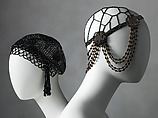On loan to The Met The Met accepts temporary loans of art both for short-term exhibitions and for long-term display in its galleries.
Headdress
Not on view
The fashion for fitted helmet-like caps in the early twentieth century developed in tandem with the growing popularity of short hairstyles for women. These cuts were influenced by wartime practicalities and the promotion of celebrity styles. Notably, the French actress Eve Lavallière cropped her hair in a “Joan of Arc” cut to secure a role in about 1910, and the famed American ballroom dancer Irene Castle initiated the “Castle bob” in 1914. Bohemian artists in Greenwich Village, like the illustrator Clara Tice, claimed to have initiated these cropped looks even in advance of celebrities like Castle.
By the 1920s a slew of new styles had been introduced that epitomized “la garçonne” look associated with the period, named after Victor Margueritte’s polarizing novel from 1922. The aesthetic was seen as relatively androgynous and emphasized cropped hair, a lithe figure, and adoption of elements from traditionally masculine dress. Headwear accentuated these looks for day and evening while echoing the interest in modernity and opulence that was found throughout apparel. This catalyzed a range of decorative hats, headbands, and wigs for every occasion, which found particular expression in the exuberance of eveningwear.
This image cannot be enlarged, viewed at full screen, or downloaded.
This artwork is meant to be viewed from right to left. Scroll left to view more.



